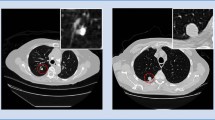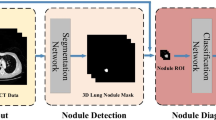Abstract
It is difficult for the existing detection methods of the pulmonary nodules to take into account the global and local features simultaneously. It will lead to over-fitting and lower sensitivity since the extracted features of 3D pulmonary nodules is too complex. To solve these problems, a model based an improved 3D residual structure (3D Res-I) was proposed to detect pulmonary nodules. In the model, the basic residual structure is improved by using rectangular convolution kernel, grouping convolution and pre-activation. Rectangular convolution kernel expands the receptive filed of the convolution, which effectively takes into account the global and local features of the pulmonary nodules. Grouping convolution reduces the computational cost of the model. Pre-activation operation alleviates over-fitting phenomenon. 3D Res-I structure is combined with the improved U-Net network as the feature extraction network of Faster R-CNN. The experimental results on LUNA16 dataset show that the proposed model improves the detection accuracy of pulmonary nodules and reduces the average number of false positives and the size of the generated model.









Similar content being viewed by others
Explore related subjects
Discover the latest articles, news and stories from top researchers in related subjects.References
Qui, S.: Study of algorithms for lung nodule segmentation and detection based on CT images. Xidian University, Xidian (2012)
Tariq, A., Akram, M.U., Javed, M.Y.: Lung nodule detection in CT images using neuro fuzzy classifier. Telkomnika. 11(2), 49–53 (2013)
Luo, X.: Research of detection algorithm of pulmonary nodules based on DICOM sequence. University of Electronic Science and Technology of China, Beijing (2015)
Miao, F.: Detection of pulmonary nodules based on correlation matrix and genetic algorithm. University of Science and Technology of China, Beijing (2018)
Keshani, M., Azimifar, Z., Tajeripour, F., Boostani, R.: Lung nodule segmentation and recognition using SVM classifier and active contour modeling: a complete intelligent system. Comput. Biol. Med. 43(4), 287–300 (2013)
Pu, J., Roos, J., Yi, C.A., Napel, S., Rubin, G.D., Paik, D.S.: Adaptive border marching algorithm: automatic lung segmentation on chest CT images. Comput. Med. Imaging Graph. 32(6), 452–462 (2008)
Dai, S., Lu, K., Zhai, R., Dong, J.: Lung segmentation method based on 3D region growing method and improved convex hull algorithm. J. Electron. Inform. Technol. 038(9), 2358–2364 (2016)
Kitasaka, T., Mori, K., Hasegawa, J.I., Toriwaki, J.I.: Automated extraction of aorta and pulmonary artery in mediastinum from 3D chest x-ray CT images without contrast medium. Proc. 4684(2009), 1496–1507 (2002)
Aykac, D., Hoffman, E.A., Mclennan, G., Reinhardt, J.M.: Segmentation and analysis of the human airway tree from three-dimensional X-ray CT images. IEEE Trans. Med. Imaging 22(8), 940–950 (2003)
Chen, X., Tian, Z.: Automatic segmentation of pulmonary parenchyma in thoracic high resolution CT. J. Shanghai Jiaotong Univ. 36(7), 946–948 (2002)
Wu, S., Wang, J.: Pulmonary nodules 3D detection on serial CT scans. In: 2012 Third Global Congress on Intelligent Systems (GCIS). Wuhan China. 257–260 (2012)
Ko, J.P., Naidich, D.P.: Computer-aided diagnosis and the evaluation of lung disease. J. Thorac. Imaging 19(3), 136–155 (2004)
Dehmeshki, J., Amin, H., Valdivieso, M., Ye, X.: Segmentation of pulmonary nodules in thoracic CT scans: a region growing approach. IEEE Trans. Med. Imaging 27(4), 467–480 (2008)
Lassen, B.C., Jacobs, C., Kuhnigk, J.M., Van Ginneken, B., Van Rikxoort, E.M.: Robust semi-automatic segmentation of pulmonary subsolid nodules in chest computed tomography scans. Phys. Med. Biol. 60(3), 1307–1323 (2015)
Li, Q., Li, F., Doi, K.: Computerized detection of lung nodules in thin-section CT images by use of selective enhancement filters and an automated rule-based classifier. Acad. Radiol. 15(2), 165–175 (2008)
Riccardi, A., Petkov, T.S., Ferri, G., Masotti, M., Campanini, R.: Computer-aided detection of lung nodules via 3D fast radial transform, scale space representation, and Zernike MIP classification. Med. Phys. 38(4), 1962–1971 (2011)
Bae, K.T., Kim, J.S., Na, Y.H., Kim, K.G., Kim, J.H.: Pulmonary nodules: Automated detection on CT images with morphologic matching algorithm-preliminary results. Radiology 236(1), 286–293 (2005)
Okumura, T., Miwa, T., Kako, J.I., Yamamoto, S.: Automatic detection of lung cancers in chest CT images by variable N-Quoit filter. In: Pattern recognition, Fourteenth international conference on IEEE. Brisbane. 1671–1673 (1998)
Sivakumar, S., Chandrasekar, C.: Lung nodule detection using fuzzy clustering and support vector machines. Int. J. Eng. Technol. 5(1), 179–185 (2013)
Boroczky, L., Zhao, L., Lee, K.P.: Feature subset selection for improving the performance of false positive reduction in lung nodule CAD. IEEE Trans. Inf Technol. Biomed. 10(3), 504–511 (2006)
Santos, A.M., Filho, A.O., Silva, A.C., Paiva, A.C., Nunes, R.A., Gattass, M.: Automatic detection of small lung nodules in 3D CT data using Gaussian mixture models, Tsallis entropy and SVM. Eng. Appl. Artif. Intell. 36, 27–39 (2014)
Li, Y.: A detection algorithm based on morphology and gray entropy for pulmonary nodules. Beijing Jiaotong University, Beijing (2011)
Murphy, K., Van Ginneken, B., Schilham, A.M.R., Hoop, B.J., Gietema, H.A., Prokop, M.: A large-scale evaluation of automatic pulmonary nodule detection in chest CT using local image features and k-nearest-neighbour classification. Med. Image Anal. 13(5), 757–770 (2009)
Kuanar, S., Athitsos, V., Mahapatra, D., Rao, K. R., Akhtar, Z., Dasgupta, D.: Low dose abdominal CT image reconstruction: an unsupervised learning based approach. In: 2019 IEEE International Conference on Image Processing (ICIP), Taipei, Taiwan. 1351–1355 (2019)
Kuanar, S., Athitsos, V., Pradhan, N., Mishra, A., Rao, K. R.: Cognitive analysis of working memory load from Eeg, by a deep recurrent neural network. In: 2018 IEEE International Conference on Acoustics, Speech and Signal Processing (ICASSP), Calgary, AB. 2576–2580 (2018)
Sharma, S., Mehra, R.: Effect of layer-wise fine-tuning in magnification-dependent classification of breast cancer histopathological images. Vis. Comput. (2019)
Gu, Y., Lu, X., Yang, L., Zhang, B., Yu, D., Zhao, Y., Gao, L., Wu, L., Zhou, Y.: Automatic lung nodule detection using a 3D deep convolutional neural network combined with a multi-scale prediction strategy in chest CTs. Comput. Biol. Med. 103, 220–231 (2018)
Bi, L., Kim, J., Kumar, A., Fulham, M., Feng, D.: Stacked fully convolutional networks with multi-channel learning: application to medical image segmentation. Vis. Comput. 33(6-8), 1061–1071 (2017)
Setio, A.A., Ciompi, F., Litjens, G., Gerke, P., Jacobs, C., Van Riel, S.J., Wille, M.M., Naqibullah, M., Sanchez, C.L., Van Ginneken, B.: Pulmonary nodule detection in CT images: false positive reduction using multi-view convolutional networks. IEEE Trans. Med. Imaging 35(5), 1160–1169 (2016)
Shen, W., Zhou, M., Yang, F., Yang, C.Y., Tian, J.: Multi-scale convolutional neural networks for lung nodule classification. Inf. Process. Med. Imaging. 24, 588–599 (2015)
Alakwaa, W., Nassef, M., Badr, A.: Lung cancer detection and classification with 3D convolutional neural network (3D-CNN). Int. J. Adv. Comput. Sci. Appl. 8(8), 409–417 (2017)
Dou, Q., Chen, H., Jin, Y.M., Lin, H.J., Qin, J., Heng, P.A.: Automated pulmonary nodule detection via 3D ConvNets with online sample filtering and hybrid-loss residual learning. In: International Conference on Medical Image Computing & Computer-assisted Intervention Springer. Cham. 630–638 (2017)
Zhao, P.F., Zhao, J.J., Qiang, Y., Wang, F.Z., Zhao, W.T.: Detection of pulmonary nodules in multi-input convolutional neural networks. Comput. Sci. 45(1), 162–166 (2018)
Yang, J.J., Wang, Q., Xuan, X.H.: Detection model of pulmonary nodules based on deep convolution neural network algorithm. Math. Model. Appl. 12.6.4:1–9+91 (2017)
Zhu, W.T., Liu, C., Fan, W., Xie, X.H.: DeepLung: deep 3D dual path nets for automated pulmonary nodule detection and classification. In: 2018 IEEE Winter Conference on Applications of Computer Vision (WACV). 673–681 (2018)
Ronneberger O, Fischer P, Brox T.: U-net: convolutional networks for biomedical image segmentation. In: The 18th International Conference on Medical Image Computing and Computer Assisted Interventions (MICCAI), Munich. 234–241 (2015)
Ren, S.Q., He, K.M., Girshick, R., Sun, J.: Faster R-CNN: towards real-time object detection with region proposal networks. IEEE Trans. Pattern Anal. Mach. Intell. 39(6), 1137–1149 (2017)
Ioffe, S., Szegedy, C.: Batch Normalization: accelerating deep network training by reducing internal covariate shift. In: 32nd International Conference on Machine learning: ICML 2015. France. 676–685 (2016)
Xavier, G., Antoine B., Yoshua B.: Deep sparse rectifier neural networks. In: JMLR: Workshop and Conference Proceedings. 15:315–323 (2011)
He, K.M., Zhang, X.Y., Ren, S.Q., Sun, J.: Deep residual learning for image recognition. In: 2016 IEEE Conference on Computer Vision and Pattern Recognition (CVPR). Laswegas. 770–778 (2016)
Xie, S.N., Girshick, R., Dollar, P., Tu, Z.W.: Aggregated residual transformations for deep neural networks. In: 2017 IEEE Conference on Computer Vision and Pattern Recognition (CVPR). Hawaii. 5987–5995 (2017)
He, K.M., Zhang, X.Y., Ren, S.Q., Sun, J.: Identity mappings in deep residual networks. In: The 14th European Conference on Computer Vision (ECCV). Amsterdam. 630–645 (2016)
https://luna16.grand-challenge.org/data/. Accessed 16 Aug 2019
Li, D., Vilmun, B.M., Carlsen, J.F., Albrecht-Beste, E., Laurudsen, C.A., Nielsen, M.B., Hansen, K.L.: The performance of deep learning algorithms on automatic pulmonary nodule detection and classification tested on different datasets that are not derived from LIDC-IDRI: a systematic review. Diagnostics (Basel, Switzerland). 9(4), 207–222 (2019)
Zhang, T.: Research on detection and diagnosis methods for pulmonary nodules based on restricted Boltzmann machine. Taiyuan University of Technology, Taiyuan (2018)
Kuanar, S., Rao, K., Mahapatra, D., Bilas, M.: Night time haze and glow removal using deep dilated convolutional network. arXiv preprint arXiv:1902.00855, 2019 (2019)
Kuanar, S., Rao, K., Monalisa, D., Bilas, M.: Adaptive CU mode selection in HEVC intra prediction: a deep learning approach. Circuits Syst. Signal Process. 38, 5081–5102 (2019)
Bakshi, A., Patel, A. K.: A novel error diffusion algorithm for Halftoning Greyscale image using pull based method. In: 2018 International Conference on Communication and Signal Processing (ICCSP), Chennai. 0305–0311 (2018)
Acknowledgements
This work was supported by the Natural Science Foundation of Hebei Province of China [Grant No. F2017202145].
Author information
Authors and Affiliations
Corresponding author
Rights and permissions
About this article
Cite this article
Shi, L., Ma, H. & Zhang, J. Automatic detection of pulmonary nodules in CT images based on 3D Res-I network. Vis Comput 37, 1343–1356 (2021). https://doi.org/10.1007/s00371-020-01869-7
Published:
Issue Date:
DOI: https://doi.org/10.1007/s00371-020-01869-7




